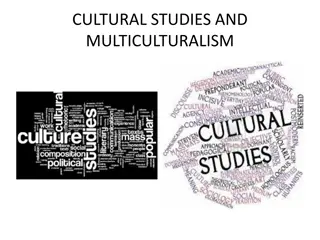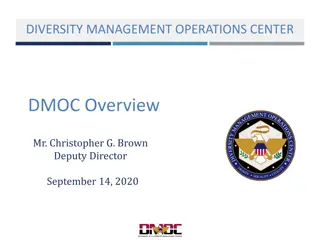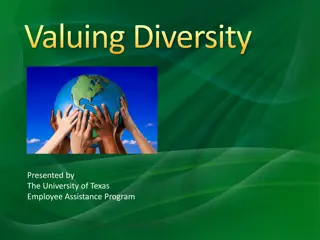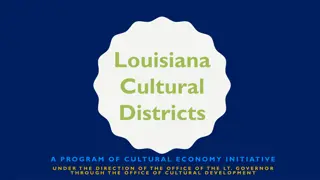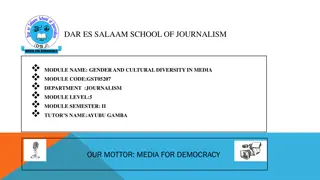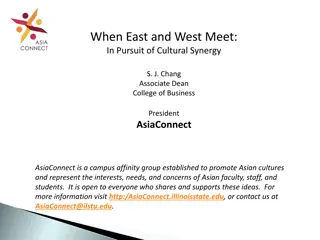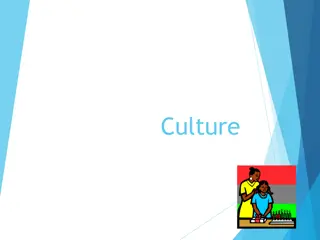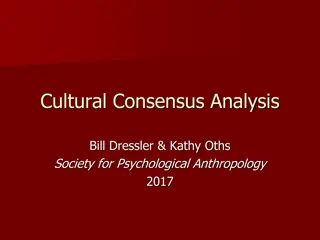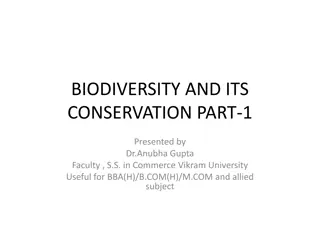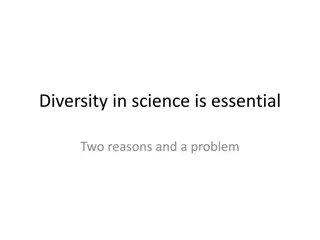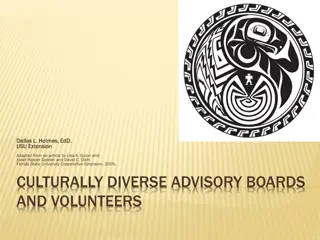
Contemporary Management Challenges and Cultural Diversity
In the realm of contemporary management, addressing cultural diversity is crucial for multinational organizations. This involves understanding and navigating cross-cultural issues, organization ethics, global workforce management, and more. By embracing cultural sensitivity and leveraging diverse perspectives, businesses can enhance their competitive edge in a multicultural environment.
Uploaded on | 1 Views
Download Presentation

Please find below an Image/Link to download the presentation.
The content on the website is provided AS IS for your information and personal use only. It may not be sold, licensed, or shared on other websites without obtaining consent from the author. If you encounter any issues during the download, it is possible that the publisher has removed the file from their server.
You are allowed to download the files provided on this website for personal or commercial use, subject to the condition that they are used lawfully. All files are the property of their respective owners.
The content on the website is provided AS IS for your information and personal use only. It may not be sold, licensed, or shared on other websites without obtaining consent from the author.
E N D
Presentation Transcript
UNIT 7 CONTEMPORARY MANAGEMENT ISSUES AND ITS CHALLENGES
INDEX Cross cultural issues in management - diversity and the new work force Organization ethics and social responsibility New ways of managing the work force Neuro- managing Globalization and its complexity. Service economy Management communication and technology knowledge management and knowledge economy.
Introduction The companies are becoming global companies Global companies leads to Multicultural organization Managing and operating global business is tougher task Human resources should be culturally sensitive Effective knowledge and use of cross cultural diversity can provide a source of experience and innovative thinking to enhance the competitive position of organizations. However, cultural differences can interfere with the successful completion of organizational goals in today's multicultural global business community.
Why culture matters in international business Developing products and services Communicating and interacting with foreign business partners Screening and selecting foreign distributors and other partners Interacting with current and potential customers from abroad Preparing for overseas trade fairs and exhibitions Preparing advertising and promotional materials It is employed in organizational settings by employing and hiring persons with various features such as age, religion, gender, sexual orientation, ethnicity, education, languages, abilities, and cultural background. By implementing this, the organization will become more inclusive.
Culture The social behavior and norms found in human societies Learned and helps to interact and communicate Helps to understand: How the members of the society live How the members behave Beliefs and values Organizational Culture When people join an organization, they bring with them the values, beliefs they have been taught They need to learn that how particular organization functions and need to adapt to it
Characteristics Observed behavioral regularities Norms Dominant values Philosophy Rules Organizational climate
Diversity Understanding that each individual is unique Recognizing our individual differences Dimensions of race, ethnicity, gender, socio-economic, status, age, physical abilities, political beliefs, other ideologies Cultural Diversity Cultural diversity is when differences in race, language, nationality, religion Residents include members of different groups
Reasons for the emergence of diversity Various groups of people are entering the workforce Helps organizations in meeting competitive pressure faced by them globally Helps in decision making process
Benefits: 1.Diverse cultural perspectives can inspire creativity and drive innovation 2.Local market knowledge and insight makes a business more competitive and profitable 3.Cultural sensitivity, insight, and local knowledge means higher quality, targeted marketing 4.Drawing from a culturally diverse talent pool allows an organization to attract and retain the best talent 5.A diverse skills base allows an organization to offer a broader and more adaptable range of products and services 6.Diverse teams are more productive and perform better 7.Greater opportunity for personal and professional growth
Challenges: 8.Colleagues from some cultures may be less likely to let their voices be heard 9.Integration across multicultural teams can be difficult in the face of prejudice or negative cultural stereotypes 10.Professional communication can be misinterpreted or difficult to understand across languages and cultures 11.Navigating visa requirements, employment laws, and the cost of accommodating workplace requirements can be difficult 12.Different understandings of professional etiquette 13.Conflicting working styles across teams
Advantages of diverse culture in the work force Improved Morale Broader Perspectives Global Impact Community Relationships How cross cultural differences complicate workplace Teamwork Lifetime employment Pay for performance system Organizational structure Union management relationships Attitudes towards ambiguity Managing culturally diverse workforce
Organization ethics and social responsibility Social responsibility is a business's duty to make ethical decisions that positively impact society. Organizations need to consider how their actions affect communities to create long-lasting trusting relationships. In order to be socially responsible, companies must strictly follow their codes of ethics. Defined as the responsibility of an organization according to the impact of its decisions and activities on the society and the environment , it involves taking into account the expectations of the stakeholders at the heart of its functioning. Depending on how a company conducts its activities, corporate social responsibility can take four different forms: Environmental responsibility. ... Ethical responsibility. ... Philanthropic responsibility. ... Economic responsibility.
Organizational ethics Organizational ethics is a set of written and unwritten codes of principles and values that govern decisions and actions within an organization. Ethics has a rather internal perspective, while social responsibility has a rather external perspective. There are three main types of ethical issues: Utilitarian - Utilitarian ethics focus on the consequences of an action Deontological - while deontological ethics focus on the act itself Virtue - Virtue ethics focuses on the character of the person acting.
Some factors to remember when managing a global workforce Cultural differences Language barriers Time zones Collaboration challenges Community gaps Employment regulations.
Tips for managing a global workforce 1. Try to be aware of cultural differences in workplace conduct 2. Accommodate employees' diverse religious needs 3. Heighten cultural awareness through training initiatives 4. Offer employees English as a second language (ESL) tools 5. Understand global employment regulations 6. Use digital tools to your advantage
Service economy A service economy is a sector of the larger economy that focuses on providing services instead of producing products and goods. In many developed nations, the service economy makes up the largest portion of the overall economy. Also known as the tertiary sector, the service economy includes industries like internet technology (IT), financial services and health care. Some examples of people who work in the service economy include doctors, lawyers, baristas, entertainers, bankers and teachers.
Three key characteristics of a service economy: 1. Abundance Unlike the other economies that rely on raw materials, the service economy relies on knowledge and skill. 2. Competition The service economy consists of some of the largest corporations in the world. While government agencies regulate some of these services, there are many services that don't require regulation. 3. Innovation Where there's competition, there's also innovation. Professionals in many service industries learn from each other and use their evolving skill sets to adapt to the needs of their customers. Those who work in the service industry are often highly innovative because it helps them remain relevant and increase profit margins.
Sectors of a service economy The service economy consists of several smaller sectors that provide a wide variety of services in a community. Transportation and storage Professional, technical and scientific services Utilities Administrative support Finance and insurance Waste management and remediation services Information Education services Real estate services Art, entertainment and recreation Rental and leasing services Health and social assistance Business management
KNOWLEDGE MANAGEMENT AND ECONOMY knowledge-based economy is occurring far too quickly. This means that we are working and conducting business in ways that were unimaginable only a few decades ago. Even more so than capital and equipment, information and knowledge assets are becoming increasingly important to productivity. Knowledge management (KM) refers to a collection of methods and tools for identifying and leveraging information and knowledge assets, particularly tacit knowledge, to enhance internal and external communication and processes. What is a knowledge economy? A knowledge economy is an economy where knowledge is the key asset. Where organizations and people acquire, create, disseminate, and use knowledge more effectively for greater economic and social development.
Four key pillars of the knowledge economy Education & Training Countries need well-educated, well-trained, and highly- skilled people to generate, distribute, and use information and knowledge. Information Infrastructure Proper information infrastructure is required for an efficient and effective flow of information, communication, and outreach. Economic Incentive & Institutional Regime The knowledge economy depends on effective policies and economic environment that promotes entrepreneurship, stimulates investment in information and communications technology (ICT), and permits the free flow of knowledge. Innovation Systems In order to ensure that knowledge and knowhow are transferred and used, an adequate network of various stakeholders from the academia, think tanks, the private sector, NGOs, and so on, needs to be in place to facilitate discussions, produce new knowledge, and adapt the acquired one to the local context.

